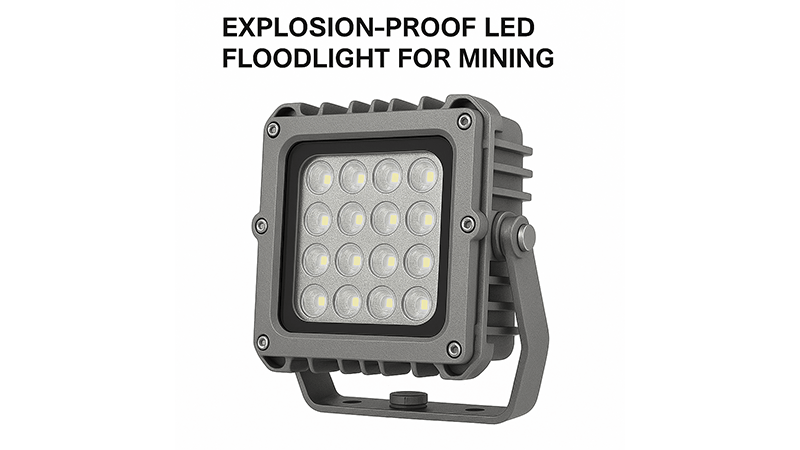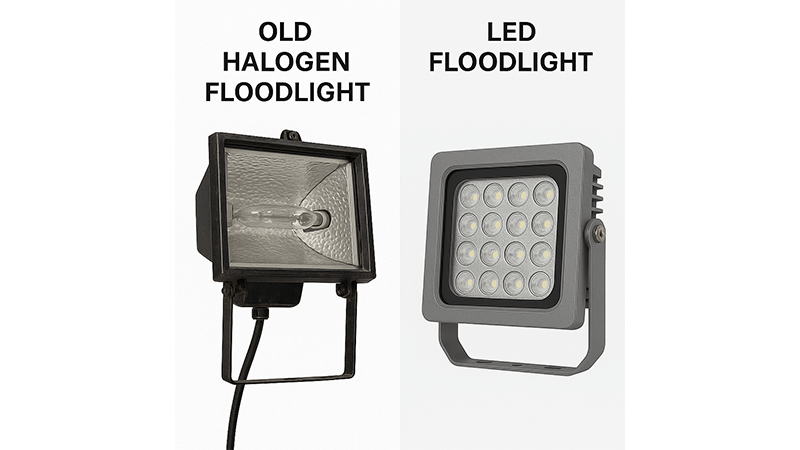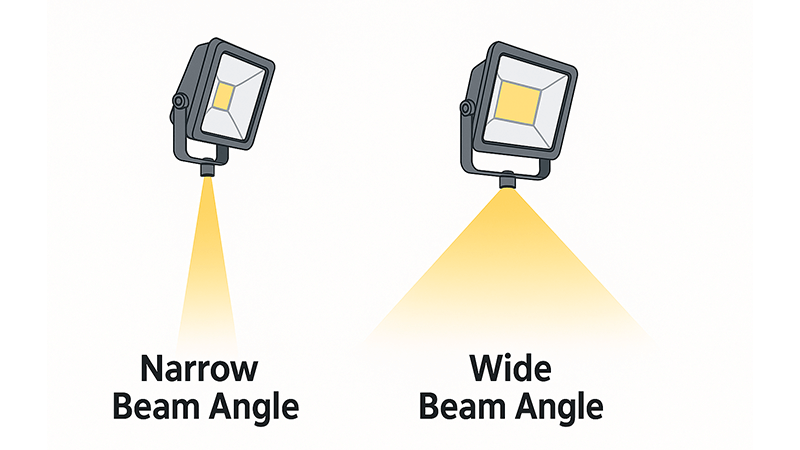Last Updated on: September 1, 2025Harsh environments demand brutally tough lighting. When a standard floodlight fails in a mine or oilfield, it means downtime, safety risks, and costly replacements. You need something built to survive.
For mining and oilfield applications, the best type of floodlight is a heavy-duty, explosion-proof LED fixture. These lights must have high IP ratings (IP66 or higher) and crucial safety certifications like ATEX or IECEx to operate safely and reliably in hazardous, corrosive, and high-vibration environments.

I’ve been in the lighting business for a long time, starting on the factory floor and building my own company. I’ve seen firsthand what happens when the wrong light is used for a demanding job. The conditions in a mine or on an oil rig are some of the toughest on the planet. You have dust, water, corrosive chemicals, and constant vibrations. You can’t just install any floodlight and hope it lasts. You need to understand the technology and choose a product specifically engineered for that stress. Before we get into the specifics for these industries, let’s cover some floodlight basics. It will help you make a much better decision.
What are the two main types of floodlights?
Choosing a floodlight feels complex with so many options. Picking the wrong technology means you are just wasting money on energy bills and frequent replacements. Understanding the two main types makes it simple.
The two primary types of floodlights are traditional, which includes halogen and high-intensity discharge (HID) lamps, and modern LED (Light Emitting Diode) floodlights. Today, LED is the superior choice for almost every application due to its incredible energy efficiency, long lifespan, and durability.

When I first started in this industry, HID lamps like Metal Halide and High-Pressure Sodium were king. They were powerful, but they came with a lot of problems. They took a long time to warm up to full brightness, they consumed a huge amount of electricity, and their lifespan was relatively short. Replacing a burned-out bulb on a high pole or piece of machinery is not just an inconvenience; it’s a costly maintenance task that involves labor and potential downtime.
Then LEDs changed everything. The difference is night and day. An LED floodlight uses a fraction of the energy to produce the same amount of light, or even more. They turn on instantly, with no warm-up time, which is a big safety feature. Most importantly, they last for an incredibly long time. A good quality LED floodlight can run for 50,000 hours or more. Compare that to the 1,000 hours of a halogen or the 15,000 hours of a good HID.
Here’s a quick breakdown:
| Feature |
Halogen |
HID (Metal Halide/HPS) |
LED |
| Lifespan |
Very Short (~1,000 hrs) |
Moderate (~15,000 hrs) |
Very Long (50,000+ hrs) |
| Energy Efficiency |
Very Low |
Low |
Very High |
| Durability |
Fragile (filament) |
Moderate (arc tube) |
Very High (solid-state) |
| Warm-up Time |
Instant |
5-15 minutes |
Instant |
| Heat Output |
Very High |
High |
Low |
| Maintenance |
Frequent |
Moderate |
Very Low |
For industrial use, especially in places like mines and oilfields, durability is non-negotiable. LEDs are "solid-state" devices. They don’t have fragile filaments or glass tubes that can break from vibration. This makes them the only logical choice for mounting on heavy machinery or in areas with constant shaking.
What type of lighting is best used for a factory?
Poor lighting in a factory is a direct cause of accidents and mistakes. This low visibility hurts your productivity, and much worse, it puts your team’s safety at risk.
For factories, high-bay or low-bay LED lighting is generally best. The choice depends on ceiling height. These fixtures give bright, even light that’s crucial for safety and clear vision. Floodlights are then used for specific large outdoor areas like loading docks and yards.

Inside a factory, your main goal is clear, uniform light over the entire workspace. For ceilings over 20 feet (about 6 meters), you use high-bay LEDs. For ceilings lower than that, you use low-bay LEDs. These lights are designed to push light straight down, illuminating the factory floor without creating dark spots. Good lighting with a high Color Rendering Index (CRI) is also important. A high CRI means colors look true and natural, which is critical for tasks like quality control, wiring, or handling color-coded parts.
Now, where do floodlights fit in? They are essential for a factory’s outdoor and large-scale indoor needs. You use them to light up the building’s exterior for security, illuminate parking lots, and brighten up loading bays so trucks can operate safely at night.
This is where quality becomes critical. I’ve seen many purchasing managers try to save money by buying cheap floodlights for their factory yards. It’s always a mistake. The biggest point of failure in a cheap LED floodlight is the driver, which is the component that converts AC power to the DC power the LEDs need. To cut costs, many manufacturers use terrible quality drivers with cheap electrolytic capacitors rated for only 85°C. In a hot industrial environment, these fail in less than a year. A failing driver causes the light to flicker, which is extremely dangerous around rotating machinery. Eventually, it will just burn out. They also use cheap wiring, sometimes copper-clad aluminum instead of pure copper. This wire has higher resistance, gets hot, and becomes a fire hazard.
What is the best type of flood light?
Everyone asks for the "best" floodlight, but that’s a vague term. You can buy a highly-rated floodlight that is completely wrong for your job, leading to frustration and wasted money.
The "best" floodlight doesn’t exist as a single product. The best floodlight is a high-quality LED fixture that is correctly chosen for its specific job. This means you must consider brightness, beam angle, durability, and features like glare control for your exact environment.

Instead of searching for one "best" light, you should look for the light with the right features for your needs. I once visited a client’s facility where they had installed powerful floodlights to illuminate their yard. The problem was, the lights had no glare control. They were so bright and diffused that they blinded the truck drivers trying to back into the loading docks. They had a lot of light, but it was the wrong kind of light. This is what I call a "bad light." A good light directs brightness only where you need it.
Here’s what to look for to find the right light for you:
- Beam Angle: This determines how wide or narrow the light spreads. A narrow beam (like 30 degrees) is for throwing light a long distance to light up a flagpole. A wide beam (like 120 degrees) is for lighting up a broad area close to the fixture, like a wall.
- Glare Control: A quality floodlight uses well-designed optics and shields to direct light onto the target area, not into people’s eyes. Cheap lights just blast light everywhere, causing dangerous glare and light pollution.
- Durability (IP and IK Ratings): The IP rating tells you how well it is sealed against dust and water. For outdoor use, you need at least IP65. The IK rating tells you how resistant it is to impacts.
- Mounting Bracket: This is a detail that is often overlooked but causes huge problems. I’ve seen cheap floodlights with flimsy mounting brackets. The adjustment mechanism is rough, and the bolts don’t lock the angle securely. After a storm with high winds, all the lights have shifted, and someone has to go back up and re-aim every single one. A robust, well-engineered bracket is not a luxury; it’s a necessity for reliable performance.
How many lumens should an outdoor floodlight be?
Choosing the right brightness feels like a total guessing game. If your light is too dim, it’s useless for security. If it’s too bright, you are just wasting energy and annoying your neighbors.
The required lumens for an outdoor floodlight depend entirely on the application. A small residential pathway might only need 700 lumens for safety, while a commercial parking lot could require 10,000 to 20,000 lumens or more to be properly illuminated.

Lumens are a measure of total light output, but more lumens isn’t always better. The key is to have the right amount of lumens for the space you are lighting. Using too many lumens is called "over-lighting" and it’s a huge waste of electricity. For specialized, massive areas like a professional sports field or a mining pit, you could be talking about hundreds of thousands of lumens.
Here’s a very general guide to get you started:
| Application |
Suggested Lumen Range |
Why? |
| Walkway / Path |
500 – 1,000 lumens |
Provides safe navigation without being harsh. |
| Driveway / Small Yard |
1,000 – 2,500 lumens |
Good for general security and visibility. |
| Building Facade (2-stories) |
3,000 – 8,000 lumens |
Highlights architectural features. |
| Commercial Parking Lot |
10,000 – 30,000 lumens |
Ensures safety and security over a large area. |
| Mining & Industrial Sites |
20,000 – 100,000+ lumens |
Extreme brightness needed for safety and operations in huge, dark areas. |
Remember, a high lumen number on the box means nothing if the light can’t sustain it. This goes back to the driver quality. A cheap LED product might claim 20,000 lumens, but its poor driver and lack of heat management will cause the light output to drop significantly in just a few months. This is called lumen decay. The LED chips themselves can last 50,000 hours, but a cheap driver will fail and kill the whole fixture in less than two years. You end up with a dim light that you have to replace, completely defeating the purpose of choosing LED in the first place. Quality components ensure the light you buy today is the light you have years from now.
Conclusion
The best floodlight for mines and oilfields is a certified, explosion-proof LED fixture. For any job, look past just lumens. Focus on quality components, robust construction, and smart design to get reliable lighting.